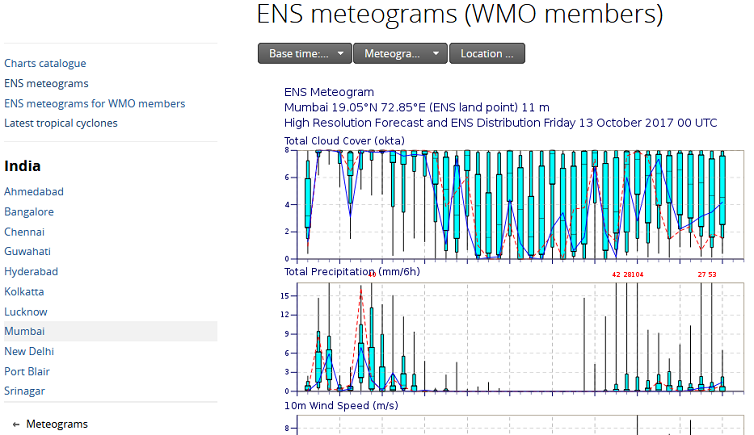

Emma Pidduck works in ECMWF’s Data Services team.
ECMWF’s primary mission is to provide numerical weather prediction data to its Member and Co-operating States. But the Centre also offers a range of licences under which other countries, researchers and businesses can obtain data that are useful to them.
Supporting those users requires know-how in weather science, data handling and consultancy. Emma Pidduck from ECMWF’s Data Services team has what it takes.
Emma’s interest in the weather and the sea stems from sailing with her family as she grew up.
She followed up a degree in ocean science, including modules in meteorology and climatology, with a PhD in estuarine physical oceanography and marine geochemistry.
Her subsequent work on probabilistic, technical and environmental risk assessments in the offshore and renewable energy industry combined scientific work with consultancy and account management.
Emma’s scientific expertise helps her to communicate with the full range of users interested in ECMWF’s data.
“The job of the Data Services team at ECMWF is to help them get the data they need by matching their requirements with what ECMWF can offer,” she says.
“We try to encourage the development of value-added services from ECMWF data. Part of this is identifying where users can amend their data requirements to be more cost-effective.”
The team looks after three main groups of users: WMO Members, academic researchers and the private sector. Emma also supports the Member and Co-operating State Catalogue Contact Points with their licensing requirements.
WMO Members
ECMWF offers WMO Members special licences which give them access to both archived and real-time data for non-commercial use.

Products accessible to WMO Members who hold a web chart licence include probabilistic predictions of total precipitation. The chart shows a five-day forecast starting at 00 UTC on 15 October 2017 for the probability that 24-hour precipitation will exceed 5 mm. The probabilities are derived from ECMWF’s ensemble forecast (ENS) for precipitation.
“More than 20 national meteorological and hydrological services now have either a non-commercial web chart licence or a full non-commercial real-time data licence,” Emma says.
“Recent weather-related disasters, such as flooding in Peru and Bangladesh, have prompted increased interest among WMO Members in our products.”
She adds that there are also a lot of resources WMO Members can access for free. These go beyond publicly available datasets.
For example, in addition to wind, temperature, mean sea level pressure, geopotential height and tropical cyclone tracks, WMO Members can access forecasts for significant wave height and relative humidity.
They can also access ensemble-based meteograms, which enable a probabilistic view of the evolution of weather variables at a given location.

Ensemble-based meteograms for selected locations are available to WMO Members on ECMWF’s website.
Archived data from the world’s biggest meteorological archive, MARS, are also available to them.
To date nearly 150 WMO Members have the user name and password required to access the free data available to them.
Researchers
ECMWF data are a valuable resource for weather-related research.
Researchers mainly come from universities and other public-sector institutes, but there have also been expressions of interest in research collaboration from the private sector. Often the projects are linked to specific field campaigns, which provide useful feedback on the usefulness of ECMWF data.
Data freely available for research purposes include the TIGGE archive (ensemble forecast data from 10 global numerical weather prediction centres) and the Sub-seasonal to Seasonal prediction database (S2S).
For wider data access, research licences are available. These are typically free of information costs but they have to be approved by ECMWF.
“They usually are if the proposed project ties in with work being done at ECMWF and can be carried out collaboratively,” Emma says.
“If researchers don’t already have a link with ECMWF, we talk to our scientists to see how the proposed project relates to research being done at the Centre.
“I enjoy finding out what different researchers are doing and how the data is being used in different areas.”

The Data Services team regularly supports researchers carrying out field campaigns. The photo shows Hurricane Patricia, which struck Mexico in October 2015. It was taken from a NASA WB-56 aircraft during a field campaign carried out by US researchers to investigate tropical cyclone intensity and structure change. ECMWF Data Services provided forecasts which helped the scientists to plan the deployment of aircraft. (Photo: Joe Gerky)
Commercial users
Businesses interested in weather forecasts come from a wide range of sectors, including energy, transport, agriculture, insurance and private-sector weather services.
The Data Services team can advise them on what kind of data is available and on what conditions.

The renewable energy industry relies on weather forecasts to predict the availability of wind and solar power. (Photo: HoleInTheBucket/iStock/Thinkstock)
“Part of my role is to help our users understand the licence conditions of the data, be it commercial or research. I also advise them on what they can do with the different types of forecast, such as deterministic and probabilistic forecasts,” Emma says.
Another common issue is the volume of data, which can run into many hundreds of gigabytes.
“I may have to talk to users about ways to reduce the data volume so that their systems can cope with it, or to reduce the cost of the data. The actual data transfer is dealt with by the technical experts in our team.”
Commercial licences may give access to archived data, web charts and tailored real-time products. A standard commercial licence also includes 24/7 support for data dissemination by ECMWF operators.
Nearly 200 companies currently hold standard or maximum-charge commercial licences.
Further information
Information on charts and datasets available from ECMWF as well as information on available licences can be found on the ‘Forecast’ page on our website.
Any inquiries about access to ECMWF data should be made using the relevant web form on the ’Contact us’ page.
